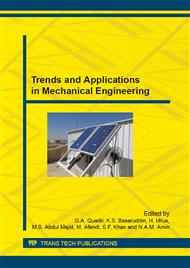p.74
p.79
p.84
p.89
p.94
p.99
p.105
p.111
p.116
Failure Stress Analysis of Adhesive T-Joint under Moisture Condition
Abstract:
The use of adhesive structural in joining application offers the great demand due to its many advantages such as lightweight structures and flexible design. However, moisture provides significant problem and adverse effect on degrading the adhesive. The strength of the adhesive reduces because mechanical properties are known to reduce also with moisture environment. Therefore, this paper discusses about the adhesive T-joint test on specimen within moisture condition and specimen without moisture, at room temperature. Additionally, this study also analyses the failure stress when load is applied for both exposed conditions. Bulk specimens are compressed at room temperature, specimen without immersing in hot water, RT and specimen with immersing in three hot water conditions 80°C, 90°C, and 100°C at a constant time of 15 minutes. The adhesive of a 1.0mm thickness has been set for T-joint tensile test. Compression test revealed that mechanical properties of Young’s modulus decreased with the increase of water temperature. Experimental results indicated that the failure stress of adhesive T-joint at room temperature and 90°C was higher compared to that of specimen soaked in 80°C and 100°C of hot water. The behaviour of adhesive joint tests under static loading analysis of experiments and the finite element analysis using ANSYS 14.0 software have shown good agreement.
Info:
Periodical:
Pages:
94-98
Citation:
Online since:
August 2015
Price:
Сopyright:
© 2015 Trans Tech Publications Ltd. All Rights Reserved
Share:
Citation:


